Lightweight Touring Binding Comparisons
We’ve now posted our reviews of each of the lightweight touring bindings in our shootout, and you should check out those reviews for detailed information on each bindings’ design features, uphill performance, downhill performance, and our overall impressions. (Each review is linked in the title of each binding below.)
In this section, we’re listing all of the bindings’ specs, then briefly going over what sets apart each binding from the others.
And then at the very end, we’ve listed a few spectrums to illustrate which bindings offer the best power transfer, which feel the least-jarring on the downhill, and which are the easiest to use overall. But first…
Picking the Right Class of Binding:
Lightweight AT Bindings vs. Heavier AT Bindings
We think it’s worth touching on the differences between this class of lightweight touring bindings and heavier, more freeride-oriented bindings like the Salomon / Atomic Shift, Fritschi Tecton, and Marker Kingpin. What do you give up by going lighter? What are the compromises? And which class of bindings should you be considering?
We’ll be going more in-depth on this topic in an upcoming Touring Bindings 101 article, but for now, we just want to help make sure that you are clear on which category of binding is going to make the most sense for you.
The good news is that this is actually fairly straightforward: If you want to ski very hard — high speeds, and / or dropping cliffs, and / or throwing tricks, etc. — then you are better off with one of the heavier freeride touring bindings. They provide far better power transfer, feel much less harsh, offer far more elastic travel (see our Bindings 201 article), have more safety-oriented features, and are overall much better suited to skiing very hard and fast compared to the lighter options in this shootout.
But a lot of people — perhaps most people — aren’t charging hard in the backcountry, and so instead of prioritizing maximum downhill performance, they prioritize lower weight, simplicity, and ease of use. And that’s where these lightweight touring bindings fit in. If you ski more conservatively in the backcountry than you do in the resort, then you probably don’t need a touring binding that gives you the same or similar downhill performance as your alpine bindings. And by compromising a bit on the downhill, you’ll get to pick from options that weigh a lot less, tour better, and are easier to use than their heavier, more downhill-oriented counterparts.
So it really just comes down to what you prioritize in your touring bindings. And with that said, let’s take a look at some of the top options in the lightweight touring binding category:
Blister’s Measured Weight:
- Toe Pieces: 124 & 124 g
- Heel Pieces: 143 & 144 g*
- Brake Units (105 mm): 99 & 99 g
- Screws (toe+heel): 17 & 17 g
- Total Weight: 383 & 384 g
- Total Weight (no brakes, no leashes): 284 & 285 g
Release Value Range: 6-12 (adjustable lateral; fixed vertical based on U-spring)
Available Brake Widths: 90, 105, 115 mm
Mounting Pattern Width: 38 mm (toe); 36 mm (heel)
Climbing Risers: flat, 31, 40 mm
Elastic Travel: 4 mm
Heel Mounting Gap: 0 mm
Heel Track Adjustment: 15 mm
Available Brake Widths: 90, 105, 115 mm
Available Crampon Widths: 80, 90, 105, 120 mm
MSRP: $395
*Our pair of Alpinists came with the long demo heel track (30 mm of adjustment vs 15 mm for the standard), which likely weighs a few grams more than the standard heel track.
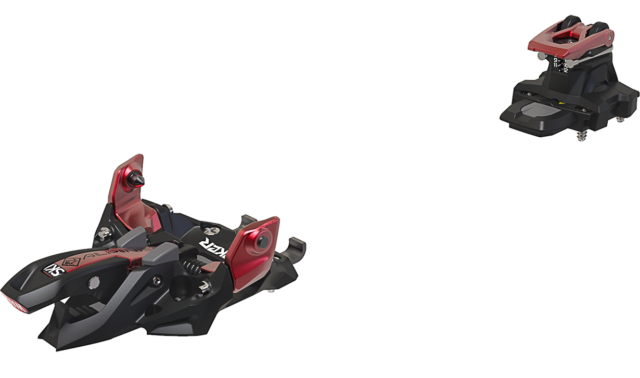
If the downhill performance of your lightweight touring binding is your top priority, then the Alpinist 12 should be near the top of your list. The Alpinist has the best power transfer and the least-jarring feel of all the lightweight touring bindings in our test (for more on this, see our full review).
The primary downsides of the Alpinist are that its heel piece can’t easily be turned using a pole tip for transitions, it’s tricky to step into, and its heel risers are the shortest in the test. All of those factors contribute to the Alpinist falling to the bottom of the test when it comes to ease of use.
But if you’re looking for a lightweight touring binding that won’t break the bank and that skis better than all the other options in this class, then the Alpinist makes a lot of sense.
Salomon MTN / Atomic Backland Tour
Blister’s Measured Weight:
- Toe: 119.3 & 118.7 g
- Heel: 163.6 & 163.9 g
- Leashes: 25.8 & 25.6 g
- Screws: 15.3 & 15.5, g
- Total: 324.5 & 323.2 g
- Total Weight (no brakes, no leashes): 298.2 & 298.1 g
Release Value Range: “women”, “men”, “expert” (adjusted by changing out U-spring in heel)
Available Brake Widths: 80, 90, 100, 110, 120 mm
Mounting Pattern Width: 40 mm (toe); 28 mm (heel)
Climbing Risers: flat, 42 mm, 58 mm
Elastic Travel: 0 mm
Heel Mounting Gap: 4 mm
Heel Track Adjustment: 30 mm
MSRP: $449
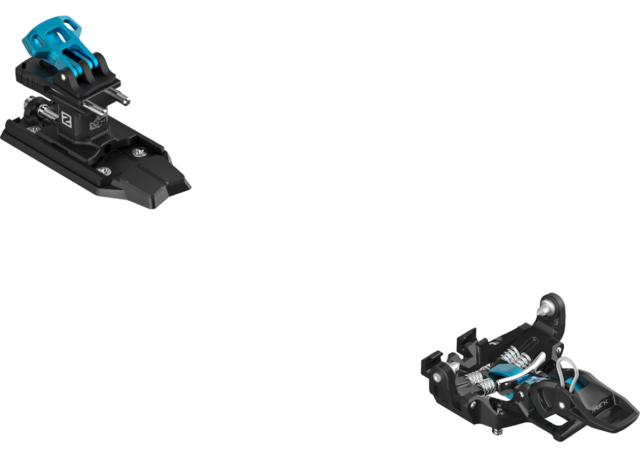
Keep it simple, stupid. That’s what Salomon and Atomic did with the MTN / Backland Tour binding. Coming in at the top of the test for ease of use, the MTN / Backland is a great choice for people who appreciate simplicity and want an uphill workhorse rather than a downhill charging machine.
The MTN / Backland Tour’s heel risers are really easy to use, its high riser is actually high, and its riser setup allows for quick transitions.
In terms of downhill performance, the MTN / Backland Tour is definitely the most traditional-feeling binding in the test. The MTN / Backland Tour feels pretty harsh on the downhill and transfers a lot of feedback from the snow to the boot. And though it’s not that far off from the TLT Speed, the MTN / Backland Tour also has the poorest power transfer of the bindings in our test.
But while the MTN / Backland Tour fell at the bottom of the downhill performance category, the differences between many of these bindings were quite subtle. So we’d be cautious about basing your decision strictly on the differences we’ve teased out in the downhill characteristics of these bindings. Again, this all comes down to what you prioritize in a touring binding.
For long tours deep in the backcountry and multi-day excursions where reliability and simplicity trump downhill performance and rich feature sets, the MTN / Backland Tour would be one of our top picks, tied with the Raider 2.0 12 / Core 12 and ZED 12.
ATK Raider 2.0 12 / Hagan Core
Blister’s Measured Weight:
- Toe: 117.5 & 117.7 g (without brakes)
- Heel: 187.3 & 188.5 g
- Brake: 54.9 & 53.9 g
- Screws: 15.3 & 15.4 g
- Total: 375.0 & 376.5 g
- Total Weight (no brakes, no leashes): 320.1 & 322.6 g
Release Value Range: 5-12 (independently adjustable both vertical and lateral)
Available Brake Widths: 86, 91, 97,102, 108, 120 mm
Mounting Pattern Width: 30 mm (toe); 45 mm (heel)
Climbing Risers: flat, 38, 41, 48, 58 mm
Elastic Travel: ~5 mm
Heel Mounting Gap: 4 mm
Heel Track Adjustment: 30 mm
MSRP: $625
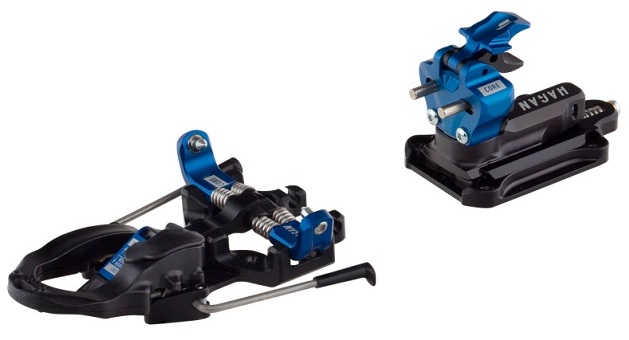
The ATK Raider 2.0 12 / Hagan Core 12 is the most expensive binding in the test, the second most feature-rich (to the ZED), and the best all-round performer. It’s one of only two non-U-spring bindings in our group, which means that you can fine-tune both the lateral and vertical release values of the Raider 2.0 12 / Core 12, and it won’t wear out the tech inserts on your boots as quickly as U-spring bindings (more on that in our full review).
The Raider 2.0 12 / Core 12 also has the best heel risers in our shootout — 5 options, and they’re all easy to actuate with a pole basket. The only thing that really keeps the Raider 2.0 12 / Core 12 below the MTN / Backland Tour when it comes to overall ease of use is the Raider 2.0 12 / Core 12’s unusual brake that’s mounted on its toe piece and its difficult-to-turn heel tower. The Radier / Core’s brake takes a bit of practice to get used to, and we doubt it would do a whole lot to stop a runaway ski on a steep slope (the brake is very small and minimal). But of course, you could just ditch the Raider 2.0 12 / Core 12’s brakes and use leashes if that’s what you prefer.
When it comes to downhill power transfer, the Raider 2.0 12 / Core 12 is the second best binding in our shootout, just behind the Alpinist. The Raider 2.0 12 / Core 12 definitely feels harsher than the Alpinist, but its burly metal construction which contributes to that harshness is also responsible for the huge amount of confidence that this binding inspires. It just feels really solid. Out of all the bindings in the test, the Raider 2.0 12 / Core 12 is the one we are least worried about when it comes to potential durability issues.
If you don’t mind its traditional tech-binding harshness and have a little extra cash to fork out, the ATK Raider 2.0 12 / Hagan Core 12 is an excellent all-round binding on both the up and the down.
Blister’s Measured Weight:
- Toe: 123.6 & 124.0 g
- Heel: 168.0 & 167.8 g
- Brake: NA
- Screws: 14.9 & 15.0 g
- Total Weight (no brakes, no leashes): 306.5 & 306.8 g
Release Value Range: 6-12 (lateral release; vertical release is non-adjustable)
Available Brake Widths: 75, 90, 105 mm
Mounting Pattern Width: 30 mm (toe); 29 mm (heel)
Climbing Risers: 15 mm, 27 mm, 41 mm
Elastic Travel: 0 mm
Heel Mounting Gap: 5.5 mm
Heel Track Adjustment: 10 mm
MSRP: $499
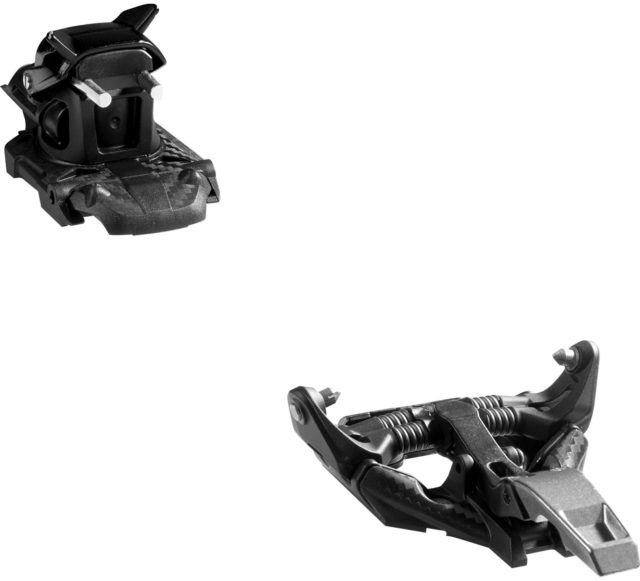
The Dynafit TLT Speed falls near the middle of the pack in most of our testing metrics. It doesn’t feel quite as harsh on the downhill as the MTN / Backland Tour or Raider 2.0 12 / Core 12, but the TLT Speed doesn’t transfer power as well as the Raider 2.0 12 / Core 12 and Alpinist.
When it comes to uphill performance, the TLT Speed is one of the easiest bindings in our test to step into. But the TLT lacks a truly flat mode for touring, and its highest riser is not very high, making it less than ideal for long, flat approaches or really steep ones.
Overall, the TLT Speed is fairly easy to use and feels a bit less harsh than some of the other bindings here. So if you stick to moderate skintracks and / or don’t need a truly flat touring option, the TLT Speed is a pretty good all-around option that tours better than the Alpinist while performing a bit better than the MTN / Backland Tour on the downhill.
Blister’s Measured Weight:
- Toe: 124.7 & 124.7 g
- Heel: 239.7 & 239.2 g (without brakes, with stomp pad)
- Leashes: 18.0 & 18.3 g
- Brakes (100 mm): 87.5 & 87.4 g
- Screws: 12.4 & 12.4 g
- Total (no brakes, no leashes): 357.0 & 358.2 g
Release Value Range: 5-12
Available Brake Widths: 85, 100, 115, 130 mm
Mounting Pattern Width: 39 mm (toe); 36 mm (heel)
Climbing Risers: flat, 36 mm, 55 mm
Elastic Travel: 10 mm
Heel Mounting Gap: 0 mm
Heel Track Adjustment: 30 mm
MSRP: $499
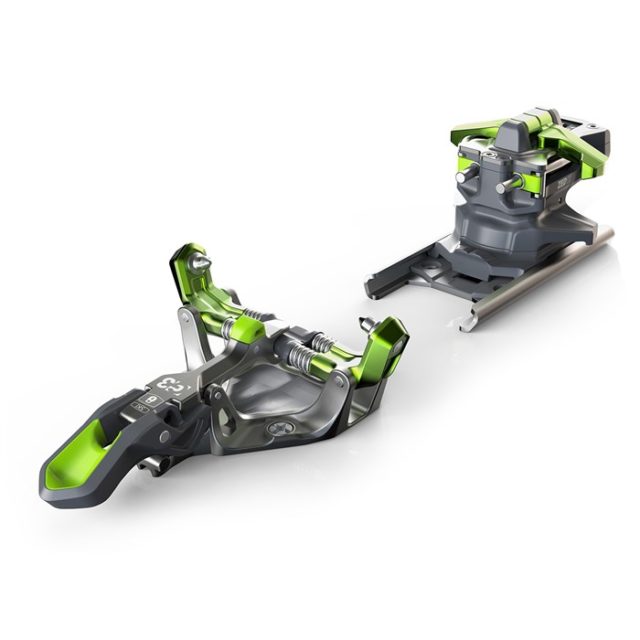
On paper, it would seem like the G3 ZED is the clear winner in the test (even though it doesn’t come in at the lowest weight). It has the most features, a reasonable price tag, and a simple design. And while the ZED is a very good binding, the ZED’s downhill performance and build quality don’t quite stack up to the Raider / Core.
Don’t get us wrong — we are big fans of this binding. When testing it head to head with the Raider / Core, our primary thoughts went more like “holy *$#!, this Raider is solid” rather than anything negative about the ZED. The ZED has a simple design for efficient backcountry travel, it skis quite well, and is far cheaper than the Raider / Core.
The ZED is probably the best in test when it comes to uphill performance and transitions. The Backland Tour / MTN is also quite good, but the ZED’s heel tower is a bit easier to manipulate with bulky gloves.
The Raider / Core is an outlier in this test — the fact that the ZED doesn’t feel as solid and confidence inspiring shouldn’t be interpreted as a knock against the ZED, but rather high praise for the Raider / Core.
All things considered (and there are a lot of things to consider when it comes to touring bindings), we would probably place the ZED second overall in the test — and if price was a consideration, it would be a very tough call between the Raider / Core and the ZED for the top spot. The ZED’s full feature set, ease of use, and simplicity are all excellent, and you get all of that at a pretty reasonable price.
Spectrums
Best Power Transfer
Marker Alpinist 12
ATK Raider 2.0 12 / Hagan Core 12
G3 ZED
Dynafit TLT Speed
Salomon MTN / Atomic Backland Tour
Worst Power Transfer
Least Jarring / Harsh on the Downhill
Marker Alpinist 12
Dynafit TLT Speed
ATK Raider 2.0 12 / Hagan Core 12
G3 ZED
Salomon MTN / Atomic Backland Tour
Most Jarring / Harsh on the Downhill
Easiest to Use
G3 ZED
Salomon MTN / Atomic Backland Tour
ATK Raider 2.0 12 / Hagan Core 12
Dynafit TLT Speed
Marker Alpinist 12
Most Difficult to Use

Really and truly who notices mounting pattern width? I went “back in time” in terms of pattern width, to the Plum RACE binding. I have run them on a range of skis from 100mm to 70mm and have toured both haute routes, the WAPTA with them. At 150 grams a binding I’m never going wider if it isn’t lighter…
Hey Apingaut, hole pattern width is more noticeable in terms of reliability and durability. The narrower the hole pattern, the more stress is put on the binding (and ski) — an effect that is multiplied by going to wider and wider skis. For things like mountain traverses and skimo races, narrow mount patterns tend to be fine because weight is at a significant premium, but for things like steep skiing and free touring, a wider hole pattern can increase the longevity and reliability of the binding.
Hi Sam. I have seen no real data to support your reliability or durability claim. The popular theory of “as we go with wider skis we need a wider binding” best I can tell it is all marketing with zero supporting data.
In my experience I have never seen a tour binding rip out that wasn’t already compromised, ALA you can’t fix a bad installation with a wider binding hole pattern. In comparison a tele binding has less screws, a narrower hole pattern, and while tele has a low reliability rap; bindings ripping out isn’t very high on the list.
Hey millerb, you’re right that data on binding failure is tough to come by from the consumer side. I would recommend listening to the GEAR:30 podcast that we did with the binding engineers at G3, as we talked a bit about binding failure modes.
When a ski is on edge, or otherwise experiences a force near the edge, a moment force (aka torque) is transferred to the binding. This size of this force is defined by: T = F x L (where T is the moment force, F is the applied force and L is the length of the lever arm)*.
In the case of a ski being stressed, the force is the strength of the impact and the length of the lever arm is the distance between where the force is applied (usually the edge of the ski) and where the binding is fixed. The moment force experienced by the binding is calculated by multiplying those values together.
Since the impact force is outside of our control, the only way to limit the moment force (torque) experienced by a binding is to decrease the length of the lever arm (L). There are two ways primary ways to decrease the lever arm length: make the ski narrower and make the binding hole mount pattern wider.
Tele bindings don’t rip out as often because tele setups have an additional degree of freedom (the same reason why every tele skier hasn’t blown all of their knee ligaments). More degrees of freedom mean the system has more ways to accommodate or react to applied loads.
In our conversation with the binding engineers at G3, they talk about how the majority of the binding failures they see are fatigue failures. These failures are caused by repeated loading that doesn’t necessarily cause plastic deformation (bending), but rather slowly wears down the binding components through any number of material failure mechanisms. The narrower hole patterns experience higher forces which accelerate this fatigue failure process.
That’s quite a long answer to your question but I hope that all makes sense. Binding design is a complicated thing, it is not an easy time to be a consumer when it comes to tech bindings!
Thanks for your comments,
Sam
*I simplified the physics a bit to make it more clear, but the concepts all still apply
I appreciate the physics behind that and understand the durability argument from wear and time. You say the only way to limit the moment force is by having a narrow ski and/or wider mount pattern. Wouldn’t a softer snow pack, say powder, also limit this force versus say hard pack or heavy, chopped crud?
I guess I’m alluding to whether or not a wider mount pattern is necessary for a powder specific ski (if your aim is to reduce moment force) since a softer snow would presumably have a lower moment force, no?
Hey Mitch! Your logic is quite sound. The only thing I would think about is that many binding failures are the result of impacts — rocks are just as hard under a foot of snow as they are under an inch of snow. An impact in powder vs hardpack should produce similar (though probably not identical) forces.
Hey Sam,
All of the description of the mechanics aside, your statement about tele bindings is pretty much the opposite of what happens, I think. You still have to produce the same moment to get and maintain a ski on its edge, but you only have half a binding to do it with. It’s why it’s so hard to get light and reliable tele bindings. Most of them are much heavier than AT bindings and even the newer light ones like the Meidjo have to have more screws than are necessary for an AT binding to help with that. Oh, and that doesn’t even get to the weight of tele boots vs AT boots, but that’s a story for another day. :)
This is a little late. I agree with you about wider mounting patterns being more durable in AT mounts, Im not sure why people are so confused about this (granted it may not be an issue very often).
I have to disagree about tele bindings ripping out less though (ask any tech at a tele shop whether AT or Tele experiences more binding pullouts/ delams). The traditional 4 hole tele mount pattern has gone extinct now that people are skiing wider skis and more powerful bindings. Tele bindings are notorious for pulling out of skis, hence all modern 75mm and NTN bindings having a wider mounting pattern and at least 6 holes in the toe. Tele bindings are subject to the force of a ski boot acting as a lever on the back screws every turn resulting in much more “fatigue”.
You need the heel raisers for the ATK bindings to properly test them against other bindings that has a heel plate.
Why not the ATK Haute Route?
Hey Gustav, are you referring to the freeride heel spacer? On each of the bindings in this test, the heel of the boot “floats” over the binding/ski (except with the Alpinist where the brake presses into the boot). The Raider 2.0 also comes in at a more comparable weight to the other bindings in this test.
Yep. You need contact under your heel on a 100mm ski in my opinion. For a ski waist of 85mm or less it’s fine to float in the air
No fritsche vipec?
At ~515 g, the Vipec EVO is far heavier than the bindings in this test. We already put the Vipec head to head with the Kingpin, Radical 2.0, and ION 12 in our Alpine Touring Binding Shootout a few years ago.
Reliability of release and retention, when appropriate, is, of course, very important characteristic of a binding for many skiers. Currently that information is mostly missing from the shootout, but in the long term it would be a very valuable addition.
Currently, there’s a mention of occasional pre-release with the Dynafit TLT Speed, and lack of similar incidents with others.
Naturally, it takes time to properly accumulate the data.
Great comparison of various new lightweight touring bindings. I think it’s interesting that with all the new models in this category over the last several years there are still some older designs that stack up really well. For example, the Dynafit Speed Turn (now the 2.0). Independently adjustable forward and lateral release, adjustable track, flat on ski mode, etc. for only around 380 grams a pair. And available for $350. With so many “new” bindings sporting old tech (u springs/fixed release), a higher price tag and not much of a drop in weight, are we really seeing progress or just new models to keep customers buying?
There are definitely some bindings in the group that employ some cool new tech, but that’s not to say that the Speed Turn 2’s aren’t a fine binding for a lot of folks. Plus, that price…
What makes these bindings ski harsher than any of the lighter weight options in the standard “Alpine Touring Binding Shootout”? How much DH performance do you gain when going to an Ion/Radical/Vipec?
I have the Salomon mtn and the g3 ion 12 and i can’t tell any difference in how they ski.
The Salomon is much harder to get in (expert spring), but it inspires more confidence in the down because the toes have a much stronger spring.
And it’s a LOT simpler.
Sam – +1. The laws of physics don’t lie. It seems obvious anyway.
What design aspects do you think contributes to you Alpinist feeling smoother and having better power transfer than the Zed per your anlaysis? The design and construction between them, and nearly all of them seem exactly the same. Are we splitting hairs here?
Seems like the elastic travel would have something to do with it, but the Zed has 10mm while the Alpinist only has 4mm.
Hi Jonathan. The short answer is yes, we are definitely splitting hairs here. As we mentioned in the piece, I strongly doubt that we would have been able to feel any of these performance differences without A/B/C/D/E’ing them directly against each other. And even so, it felt like we were splitting hairs when writing this piece. Binding performance is just a hard thing to tease out. The Alpinist / ZED question isn’t one with a clear answer. In your purchasing decisions, I would focus much more on features that you want and ease of use rather than downhill performance (unless you strongly value durability, then go Core/Raider). Sorry I couldn’t be more help!
What about Plum Pika? The best in the range in my opinion…
We haven’t been able to us it yet, but we’ve been told by Plum that they’ll be sending that and the Summit 12 for reviews this season, so we’re looking forward to trying them.
I have had the opportunity to try out the Plum Pika.
I’m I the only one that has noticed that when skinning with a locked toe, the front of the boot will push the toe-lever into ski mode if the boot is pivoted forward far enough?
This occur when skinning upwards, typically when stretching out the leg before swinging the outside ski around, thus pivoting the boot forward. This immediately result in pre-release, a rather annoying thing to have happen on most every turn on the up, potentially dangerous when skinning in treacherous terrain.
I used the Dynafit Vulkan boot on this occasion, and upon my return I tried every other boot at hand in the binding; TLT6, Atomic Backland, Dynafit neu and Scarpa Maestrale – same thing, when pivoted forward they all push the toe-lock of the binding forward and into ski mode!
I have skied several Dynafit bindings, ATK’s and even the Plum Guide in my time, none of which have had this issue when in normal use. When bench-testing these boots across the different bindings, the Dynafit bindings where the only binding to «give away» one single click when fully locked out, and this happened only with the Dynafit Vulkan’s on an extreme forward pivot.
Am I missing something here or is this a major design-flaw on Plum’s part?
@Hellsegg did you have any further experience with the Pika since writing this? I was considering getting a pair because I like the design – specifically being able turn the heel 90 degrees either way to get a choice of flat or riser mode that is easy to manipulate with the pole basket. I don’t mind the single riser. But what you say here has me feeling cautious, as, if I understood you correctly you can kick the binding out of tour mode when uphilling – if that’s right I agree this would be unacceptable.
I love this article and often reference it and share with friends. Chiming in with my $0.02. The G3 Zed is really quite a handsome package, and wanted to add a voice of support there. I really can’t believe that they built such a solid binding at 350g. Emphasizing also how much the ease of use matters here. I was out on a tour in the Whistler Backcountry with no fewer than 6 transitions (meaning 6 ups and 6 downs) over the course of the day. Having a simple, easy binding was a real treat and got me through those transitions with remarkable ease. Great binding.
Where would you slot in the new ’21 ATK Rader 12 into these rankings? Does it pretty much mirror the ATK Raider 2.0? Or does it provide any more power/smoothness?